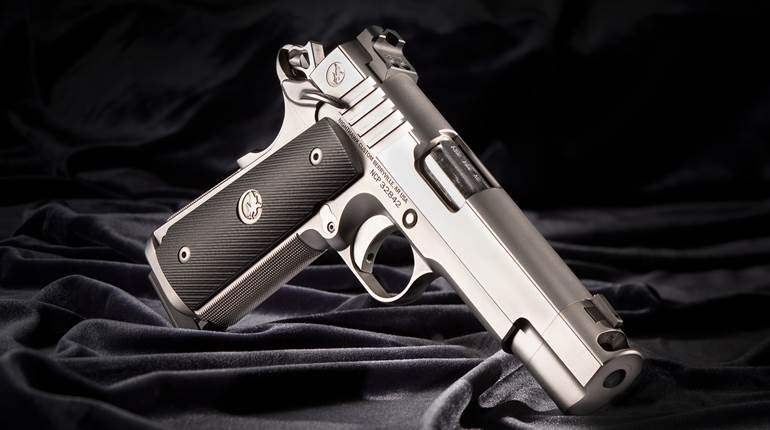
Every new technological advance has critics. When anything new hits the market, there are those among us who will cling to the old ways and others who will criticize the advances for “going too far.” Ultimately, though, the buying public decides if it will embrace the new technology or reject it. If it brings something better to the table, it will sell. If not, it won’t.
Remington thinks its new sighting system-the 2020-is the future of long-range hunting, yet before it was even shipping there were cries to outlaw it, some from people within the shooting industry. Personally, I look at how technology has improved our lives and think the market should decide. The lingering questions, though, are simple, “Is this sighting system the next big thing? Is it a game changer for shooters? Or is it hype that will disappear?”
My opinion is that it has elements of each, and which one wins out depends on Remington. Before I explain that statement-let’s take a look at the back story on the Remington 2020 sighting system.
Tracking Point
In January 2013, a Texas-based company called Tracking Point introduced a new integrated rifle and sighting system in which a video screen scope with an internal laser rangefinder to measures the distance to the target and, using the latest in digital technology, factors in temperature, barometric pressure, incline/decline, cant, air density, magnus effect drift (spin drift), target movement and Coriolis effect drift. The internal computer then factors all that in with stored ballistic and firearm information including lock time, ignition time, in-barrel time, rate and direction of twist, muzzle velocity and ballistic coefficient. The unit can compensate for wind drift, but the shooter must manually input the wind speed information.
To make this all work, the shooter places a “tag” on the target by centering the crosshair  on his intended point of impact and pushing and releasing a button. The tag then feeds information to the computer, which is updated at a rate of 52 times per second, and the scope uses the combined data to calculate a “Ballistic Solution.” The unit then adjusts the image on the video screen to compensate and allows the shooter to aim the centered reticle where he wants to hit, regardless of the distance, or even if the target is moving.
on his intended point of impact and pushing and releasing a button. The tag then feeds information to the computer, which is updated at a rate of 52 times per second, and the scope uses the combined data to calculate a “Ballistic Solution.” The unit then adjusts the image on the video screen to compensate and allows the shooter to aim the centered reticle where he wants to hit, regardless of the distance, or even if the target is moving.
The unit has video recording capability so that the shooter can record before, during and after the shot. It also has a built in Wi-Fi system that allows the view through the scope to be seen simultaneously on an iPad or iPhone. This Wi-Fi system will also download videos to your device and can be used in the other direction to make some internal adjustments to the sighting system.
The Tracking Point system’s trigger is integrated to the sighting system, and the rifle will not fire until the aiming point is exactly aligned with the previously placed tag. One version of the Tracking Point System is rated out to 1,200 yards, but ammunition is restricted solely to three loads by Barnes.
There are a few issues, some real and some imagined, surrounding the Tracking Point. The imagined is mostly based in the myths and misunderstandings about the integrated triggering system. The gun does not fire on its own as is believed by some uninformed critics. It can only fire when the reticle is aligned with the previously placed tag and the trigger is pulled. It is possible to pull the trigger while aiming off target and then, holding the trigger back, move the gun until the reticle and the tag are aligned. At that point the gun will fire. But the gun can only fire at a previously tagged target and only if the shooter is applying pressure to the trigger when the tag and the reticle align.
The main issue is the cost, as the Tracking Point rifle and optical systems range from $22,500 to $27,500. That high price eliminates all but the very well-heeled segment of the shooting public. But now there is a less-expensive option from Remington.
Enter Remington
The CEO of Tracking Point, Jason Schauble, used to work for Remington, so he got together with some of his old colleagues and they struck a deal for a new system called the Remington 2020. It does not have all the capabilities of the Tracking Point system, but does have most of its features. It does not have those issues creating the most controversy: The Remington 2020 system does not use an integrated trigger, and will operate independent of the sighting system.
The 2020 is sold as a package with a specifically matched Remington or Bushmaster rifle, and it is programmed to that rifle and a few specific ammunition products-it does not integrate with the rifle’s trigger. In fact it is simply an aiming tool, just like any other scope. While the laser rangefinder on the Remington 2020 is capable of measuring out to 750 yards under ideal lighting and target conditions, the software in the system is programmed to work to 500 yards. Because Remington is aiming (pun intended) at the hunting market, this helps control some of the “ethics” objections about shooting game animals at ultra-long range. Also, the units are still pricey. The 2020 has a suggested retail price of $5,500 with a Bushmaster Varminter rifle in .223 Rem. and $5,575 for a 2020 on a Remington Model 700 Long Range in .30-’06 Sprg. or the Model 700 SPS Tactical in .308 Win.
Each of the 2020 systems has software that allows the use of three different factory loads, one by Barnes and two from Remington. At this time there is no provision for the user to program in either handloads or any ammunition other than those pre-chosen by the manufacturer and programmed into the device.
The unit uses a video screen, so the shooter is in effect watching a movie of what the scope is seeing. They like to call this a “heads up display” (HUD). On the Remington 2020 screen there is a lot of other information that you will never find through a traditional riflescope.
On the left, top to bottom are: target speed and target range; ammo selection; mode selection; incline and a “check scope reminder” symbol. (Sort of like your check engine light, I guess.) On the right are: wind setting; recording time remaining; Wi-Fi status; battery status and an indicator of which battery is being used; tag off-screen indicator and the inclination indicator. Along the bottom left to right are: time; date; zoom level; compass; barometric pressure and temperature. Also centered in the bottom of the screen is a cant indicator to tell you if the rifle is tilted. Top center is the target zone indicator, which is the sensitivity of the “ready to shoot function.” When the crosshair is aligned on the tag and the gun is ready to fire, the crosshair will change from blue to red, indicating that the shooter can now fire and expect to hit the tag location. But, if the crosshair moves off the tag, it changes back to blue indicating that a shot will miss the tag location. If the gun required the tag and the crosshair to be exactly overlaid before the reticle changed color, it would be impossible to use as you could never hold the gun steady enough. So the shooter is able to adjust the size of the “target zone” in a range from 0.1 minute-of-angle (m.o.a.) to 4 m.o.a.
The shooter determines where to shoot as the tag and crosshair do not have to be aligned for the gun to fire. The shooter can place a tag on the target at an easy location to create the ballistic solution and then use the crosshairs to shoot where he wants to hit, just like a traditional scope. When hunting you can simply tag a deer any place the tag will stick to get the ballistic solution, and then aim at the vitals just as you would with any other scope.
The 2020 has three modes. “Advanced Targets” is for stationary targets, while “Advanced Movers” is for moving targets and has a predictive capability that will allow for a target moving up to 10 m.p.h.-simply aim where you want to hit and the scope makes the calculations and adjustments for lead. “Traditional Mode” is a mil-dot reticle with a 100-yard zero. The rangefinder still works in this mode, but the computer makes no changes and the scope functions more or less like a traditional scope where the shooter must hold over for a long shot.
The unit runs on two rechargeable, proprietary batteries. It uses one at a time so they can be hot-swapped. Expected life is about 1.5 hours for each battery. Of course, that is subject to ambient temperature, Wi-Fi use and other factors.
The unit is simpler to use than you might expect. I put the 2020 in the hands of my 15-year-old, video-game-addicted nephew and his buddy at the range, and they mastered it in no time. I showed his friend a few things as he was first shooter and, when it was my nephew’s turn, I started to show him. He looked up and said, “I got this, Uncle Bryce.” Then he started hitting small targets time after time with almost boring regularity.
Scott Ballard, a long-range shooting instructor at the SIG Sauer Academy, worked with me to test these rifles. He started off like most of us old gun guys, politely skeptical and mumbling “what the hecks” under his breath. But, after a half an hour or so, they changed to loudly proclaimed statements of, “This thing is pretty cool!”
All the ballistic solutions are predicated off a 100-yard zero, which is set at the factory, but the unit has a function for the shooter to adjust the zero. Once we had the zero confirmed, Ballard and I tested the gun out to its stated capability of 500 yards for the Remington 2020. (We did the same thing at 750 yds. for the Tracking Point System in .300 Win. Mag.). The ballistic solutions worked very well at every distance. We were able make center hits on targets at any range. I used the 2020 on a Bushmaster Varminter in .223 Rem. to ring 8-inch steel targets at 500 yards with every shot.
During another session, the same rifle delivered a five-shot group at 400 yards that measured 2.8 inches. We could also hit a 6-inch swinger plate at that distance every time. So, I am a believer in the ballistic system. It does a good job of compensating for the range.
Emerging Technology
But it’s not all rose petals and unicorns; there are a few issues. First of all, it’s a video screen. Have you ever tried to use your digital camera or iPhone in bright sunlight? Same thing here, it’s hard to see. The long eyecup helps. So does the detachable filter. But for a rifleman used to optical scopes, the image is not bright in any lighting situation and hard to see in some.
This is a digital zoom, so image quality degrades with increased magnification. I know they are working on this, and it’s being improved constantly, but when I hunted last spring with the Tracking Point system it was very difficult to identify any long range target when zoomed out.
The units had a tough time placing and maintaining a tag in lighting conditions other than perfect. They also had trouble with contrasting color targets such as a black target with a white center or a target covered with dappled shadows.
The 2020 unit is in a 100-yard view when you start, and when you place the tag it shifts the image to the distance that the tag indicates. If you place a tag at very long range, the unit will shift the image to adjust for the distance, and you may lose sight of the target. If the image moves off the limits of the screen (basically the 100-yard, pre-zoom view) you will lose the tag. At the very least you will need to reposition the rifle so that you can see the image and tag at long range.
This system of placing a tag and then going to the gun to shoot is slow. Most of the time it works well, but it never works fast.
This system is not for everybody. If you are a hard-core shooter, one that has been doing this long-range thing for a while, I encourage you to try the system. But, I’ll bet you will be bored with the simplicity and consistency of it pretty quickly and may decide it’s not for you. It does take the shooting out of shooting, particularly the Tracking Point Version. But then again, that’s kind of the point. This is the best system I have tried to ensure a first-round hit at long range. But the computer makes it happen, not the shooter or spotter.
However, if you love new technology, if you are the kind of guy who stands in line all night to be the first to get a next generation iPhone; if you like to be able to say that you were there when history was made and that you were part of it, this is your shooting system.
I hope there are a lot of shooters who want in on the ground floor of this technology because without them, it withers here in the first generation. I truly believe this can be game-changing technology. The visionary shooter, the early innovator, the explorer, those who love technology, need to embrace it, buy it and force Remington and Tracking Point to evolve and develop this technology and bring this from the Model T to the modern Mustang. That’s how game-changing technology develops. If the product provides enough quality and performance to attract early buyers, and if the company recognizes this enough to keep pouring its money back into research and development, refining the concept, then I truly believe this will change the way we shoot rifles at long range.
Tracking Point Shotview
This software lets you use an iPhone or iPad to see the same thing that the shooter is seeing through the scope. It’s very handy for instructing new shooters as well as for guides to insure they are on the correct animal. You can get it at the App Store, along with Tracking Point’s Precision Hunter Lite game.
Manufacturer: Remington Arms Co., Inc., 870 Remington Drive, Madison, NC 27025-0700; (800) 243-9700
Magnification And Objective: 3-21X digital-zoom optics
Construction: extruded and cast aluminum housing
Finish: hard-anodized, matte-black finish
Field Of View (ft. at 100 yds.): 18',8" vertical x 25' horizontal @ 3X; 2', 8½" vertical x 3', 7" horizontal @ 21X
Adjustments: +/- 40 m.p.h. of cross wind, zero adjust of +/- 4 m.o.a. in vertical and horizontal (digital inputs)
Reticle: mil-dot on boot-up (traditional mode), Advanced Ballistic Tracking Reticle (advanced mode)
Length: 10.3"
Width: 3"
Height: 3.75"
Weight: 58 oz. (with two batteries installed; 4 ozs. each)
Tracked Target Accuracy: 0.1 – 4.0 m.o.a. (user adjustable);
Laser Rangefinder Range: 750 yds. (on whitetail deer)
Laser Rangefinder Accuracy: +/- 1 yd.
Tracked Target Range: 50 -500 yds.
Maximum Tracked Target Speed (for leadcalculation): 10 m.p.h.
Internal Video Memory: 2 hours
App Operating Systems: Apple iOS and Android
Accessories: dual battery charging cradle, four batteries, eye guard, hard-side custom-cut foam case, 300 rounds of profiled ammunition (100 each: target, traditional (lead-core) hunting and alternative Barnes Vor-tx TSX)
Additional features: 802.11g Wi-Fi server with live video streaming to smart device
Suggested retail price: $5,500 (Bushmaster Varminter); $5,575 (Model 700 Long Range); $5,575 (Model 700 SPS Tactical in .308 Win.)






































